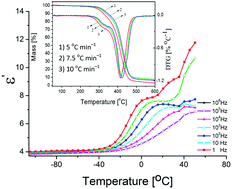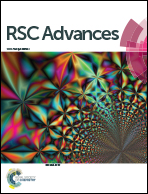Novel bio-based flexible epoxy resin from diglycidyl ether of bisphenol A cured with castor oil maleate†
Abstract
The paper deals with the synthesis, thermal and electrical behavior study of a flexible epoxy resin based on castor oil maleate and diglycidyl ether of bisphenol A. Castor oil maleate was obtained via esterification of castor oil with maleic anhydride. The chemical structures of the castor oil maleate and epoxy network were confirmed by FTIR and 1H-NMR spectroscopy. Thermal decomposition of the synthesized flexible network has been studied by means of dynamic thermogravimetry in a nitrogen atmosphere up to 600 °C. Global kinetic parameter values of the thermal decomposition process were determined using the isoconversional method of Friedman. Simultaneous TG-DTA analysis indicated that the thermal decomposition process occurred in three stages, characterized by diffusion, n order and Avrami–Erofeev reaction models. Kinetic parameter determination, corresponding to each individual stage of the thermal decomposition, was also possible through a multivariate non-linear regression method. A good correlation was found between the experimental and simulated data. Evolved gas analysis was monitored by a simultaneous TG/DTA-FTIR-MS technique. Dielectric relaxation spectroscopy measurements were also undertaken.


 Please wait while we load your content...
Please wait while we load your content...